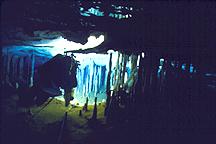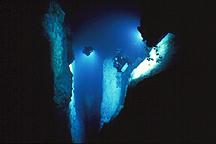![]()
The Bahamas have been, for many years now, synonymous with a vision of sandy beaches, swaying palm trees, casinos and cool drinks - a tourist's paradise of almost mythical proportions.
The Bahamas which lie behind the beaches, and beneath them, are rather different. There are over 700 islands, large and small, in the Bahamas group, and few of these offer much for the average tourist. Lush, subtropical forests of pine or broad-leaved scrub cover much of what higher ground there is, saline mangrove flats cover most of the rest, and the ground itself is karst, often broken and jagged, a bare limestone surface where the only soils are in potholes, or "banana holes", in between the fretted ridges, or soft oolitic deposits between the tangled mangrove roots. It is a natural paradise, but not for the faint of heart. For those who love nature, it is paradise indeed.
Limestone is a rock susceptible to cave development. Bahamian limestone is no exception. Despite the lack of surface rivers, in the present era, or much in the way of surface relief at all, the major islands are underlain by extensive cave systems, often stretching for many kilometres, and which may reach underwater depths in excess of 100 metres. These caves have formed largely as a result of slow dissolution of the rock at the base of the islands' freshwater lenses, and by the collapse of cavern roofs when the caves grew too large to support them. This collapse happened more frequently during periods of low sea level, when much of the Earth's water was frozen into the great glaciers of the Ice Ages. Where collapse continued to the surface, entrances to the underworld were formed. As the oceans rose, these caves were filled once again with water, and the entrances became lakes on the land, or deep, dark openings in the shallow lagoons inside the fringing barrier reef. These lakes and openings are the Blue Holes of the Bahamas.
 These Blue Holes are
scattered throughout the islands, either forming deep, circular cenotes (similar to those
in Yucatan) in the interior, or as a series of more irregular entrances, generally aligned
along one or more large fracture zones that parallel the Tongue of the Ocean and other
abyssal canyons off the eastern coasts of the islands.
These Blue Holes are
scattered throughout the islands, either forming deep, circular cenotes (similar to those
in Yucatan) in the interior, or as a series of more irregular entrances, generally aligned
along one or more large fracture zones that parallel the Tongue of the Ocean and other
abyssal canyons off the eastern coasts of the islands.
The serious exploration of the Andros caves began in the late 1950's, when a Canadian diver, photographer and cave explorer called George Benjamin took an interest in the caves. For over 15 years, George catalogued entrances and explored passages inside the openings, until many of the most obvious caves had been documented. The centrepiece of this work was the exploration by George and his team of what has become known as "Benjamin's Blue Hole", in the South Bight of Andros.
In this cave, and in several nearby caves, over a mile of passages were explored and mapped, and brief excursions made to depths of up to 300 feet. Both Benjamin and Jacques Cousteau made television films within the system, and Blue Holes became known in the public world outside the Bahamas for the first time. Erich Von Daniken, in his book "Chariots of the Gods", speculated that the deep circular inland Holes might be the launching pads of ancient extra-terrestrial visitors - a somewhat fanciful notion!
 Benjamin's explorations
ended in the mid-1970's, shortly after the deaths of some of his diving companions within
the caves, and in the depths of the Tongue of the Ocean. From then, there was little
serious exploration of the Andros Blue Holes until the arrival of British cave divers in
the early 1980's, the one notable exception being a visit by the famous American cave
diver, Sheck Exley, in 1975. Exley, a support diver on Archie's ill-fated dive, and his
companions explored one Blue Hole in the South Bight of Andros, near to Benjamin's Hole,
to a then world-record depth for an underwater cave of 340' (112m).
Benjamin's explorations
ended in the mid-1970's, shortly after the deaths of some of his diving companions within
the caves, and in the depths of the Tongue of the Ocean. From then, there was little
serious exploration of the Andros Blue Holes until the arrival of British cave divers in
the early 1980's, the one notable exception being a visit by the famous American cave
diver, Sheck Exley, in 1975. Exley, a support diver on Archie's ill-fated dive, and his
companions explored one Blue Hole in the South Bight of Andros, near to Benjamin's Hole,
to a then world-record depth for an underwater cave of 340' (112m).
Meanwhile, on Grand Bahama, American cave divers were exploring the Lucayan Caverns, discovering over 8 kilometres of passages in what was then the most extensive underwater cave system in the world. In the mid-80's it became the Lucayan National Park. The Lucayan Caverns were where biologist Jill Yager discovered a new order of marine life, Remipedia, a group of crustacean thought to have become extinct over 150 million years ago. Many new species have been discovered in inland and marine Blue Holes, and similarities to deep sea environments have been noted.
Under the leadership of Rob Palmer, two expeditions to the north of the Andros in 1981 and 82 resulted in the exploration of Conch Sound Blue Hole to a point 1200 metres from its entrance, making it at that time the longest submarine cave known in the world. Many other nearby caves were explored, and a programme of academic research was inaugurated.
 During 1983 and 84, the
British team turned its attention to eastern Grand Bahama, discovering the beautiful and
biologically important Zodiac Caverns below Sweeting's Cay, and the deep marine fracture
systems of Big Creek.
During 1983 and 84, the
British team turned its attention to eastern Grand Bahama, discovering the beautiful and
biologically important Zodiac Caverns below Sweeting's Cay, and the deep marine fracture
systems of Big Creek.
In 1985, the youth expedition "Operation Raleigh" visited South Andros, and a team under Palmer's direction added to the catalogue of known cave sites, working largely within the forests inland, and discovering deep cave sites along one of the major fracture lines paralleling the coast. "Stargate", one of the most magnificent of all Blue Holes, was discovered during this period.
The years 1986 and 1987 saw the first major integrated scientific study of the Andros Blue Holes. The international Andros Project was extremely successful, contributing much in the way of original scientific work in the geological and hydrological processes at work below the islands, and in studies of palaeo-climatic change in the Earth's past. It also pioneered the use of mixed gas diving techniques within the Blue Holes, using mixed gas rebreather to reach depths of over 90 metres below the island. More than 40 Blue Holes were explored for the first time on this expedition, and a programme on the project was produced for National Geographic's Explorer series.
 The 90's have seen work
focus again on Grand Bahama, where scientists and cave divers from the University of
Bristol have been continuing a programme of exploration and research in the Lucayan
Caverns and the Owl Hole System, studying the hydrology and geology of the caves. This
work has contributed considerably to an understanding of water flow and chemistry beneath
the Bahamas and similar carbonate islands. More work has been done on stalagmite dating,
part of an ongoing programme of palaeo-climatic research, and this has unraveled some of
the mysteries of sea level change over the past millennium. Research is now focusing on
the geomicrobiological processes at work within the caves, as studies reveal how important
a role the smallest of all life - bacteria - play a part in the formation of the caves.
The 90's have seen work
focus again on Grand Bahama, where scientists and cave divers from the University of
Bristol have been continuing a programme of exploration and research in the Lucayan
Caverns and the Owl Hole System, studying the hydrology and geology of the caves. This
work has contributed considerably to an understanding of water flow and chemistry beneath
the Bahamas and similar carbonate islands. More work has been done on stalagmite dating,
part of an ongoing programme of palaeo-climatic research, and this has unraveled some of
the mysteries of sea level change over the past millennium. Research is now focusing on
the geomicrobiological processes at work within the caves, as studies reveal how important
a role the smallest of all life - bacteria - play a part in the formation of the caves.
The caves have also revealed secrets of the island's more recent past - in 1987, at the end of the Andros Project, Palmer discovered the skeletons of several Lucayan Indians in a Blue Hole on South Andros. In 1990, a joint operation with the Bahamas Department of Archives and the Bahamas Archaeological Team, brought fragments of 16 skeletons to the surface, which, together with other, more recently discovered artefacts such as a Lucayan canoe possibly 1000 years old, from Stargate, are still being studied.
To further reveal the frontiers of Blue Hole potential, American diver Jim King made a mixed gas exploration to nearly 200 metres in Dean's Blue Hole on Long Island in 1992, showing that Blue Holes may plunge far deeper than previously thought, while Palmer, Dean and other divers on a Foundation expedition in 1995 explored a new system on Acklins Island, called the "Ocean's Den", for over 5000 feet (1500m) of passages in a single 5 day period. There is much more still to be found.
The Blue Holes offer much to exploration and science. They offer the rare chance to go where no other has ventured before; they offer an enormous potential for important original scientific research, and they offer a unique potential for education - the chance to study and learn how to look after a new environment, and how to sustain it for future generations of explorers and scientists. This is what we wish to share with others. Our commitment is to conserving this environment, and to sharing discoveries, not just with scientists, but with ordinary people, with school children and with those who do not have the opportunity to themselves venture within the caves, is a firm commitment to share knowledge and adventure with all who wish to join in the exploration and study of the Blue Holes of the Bahamas.